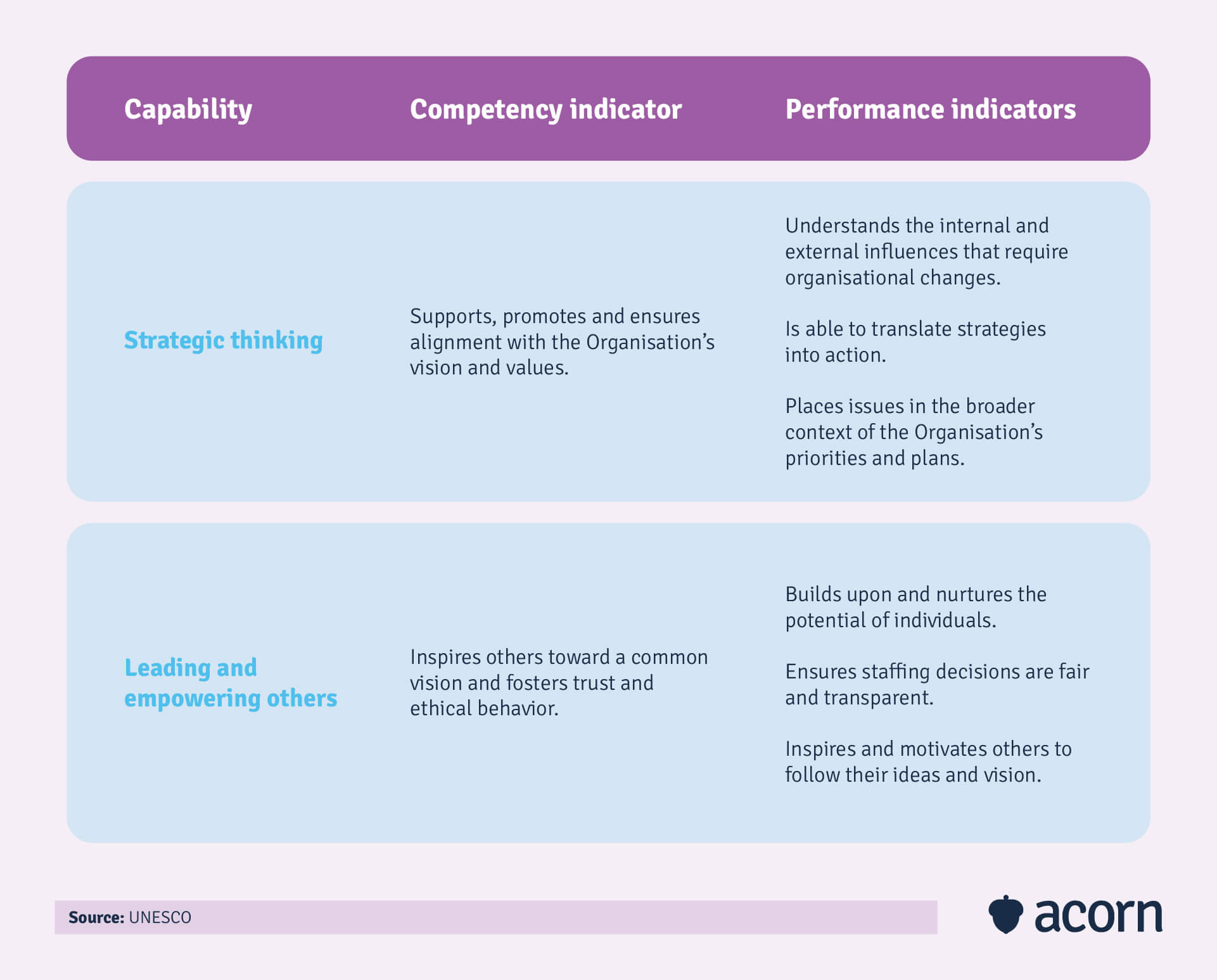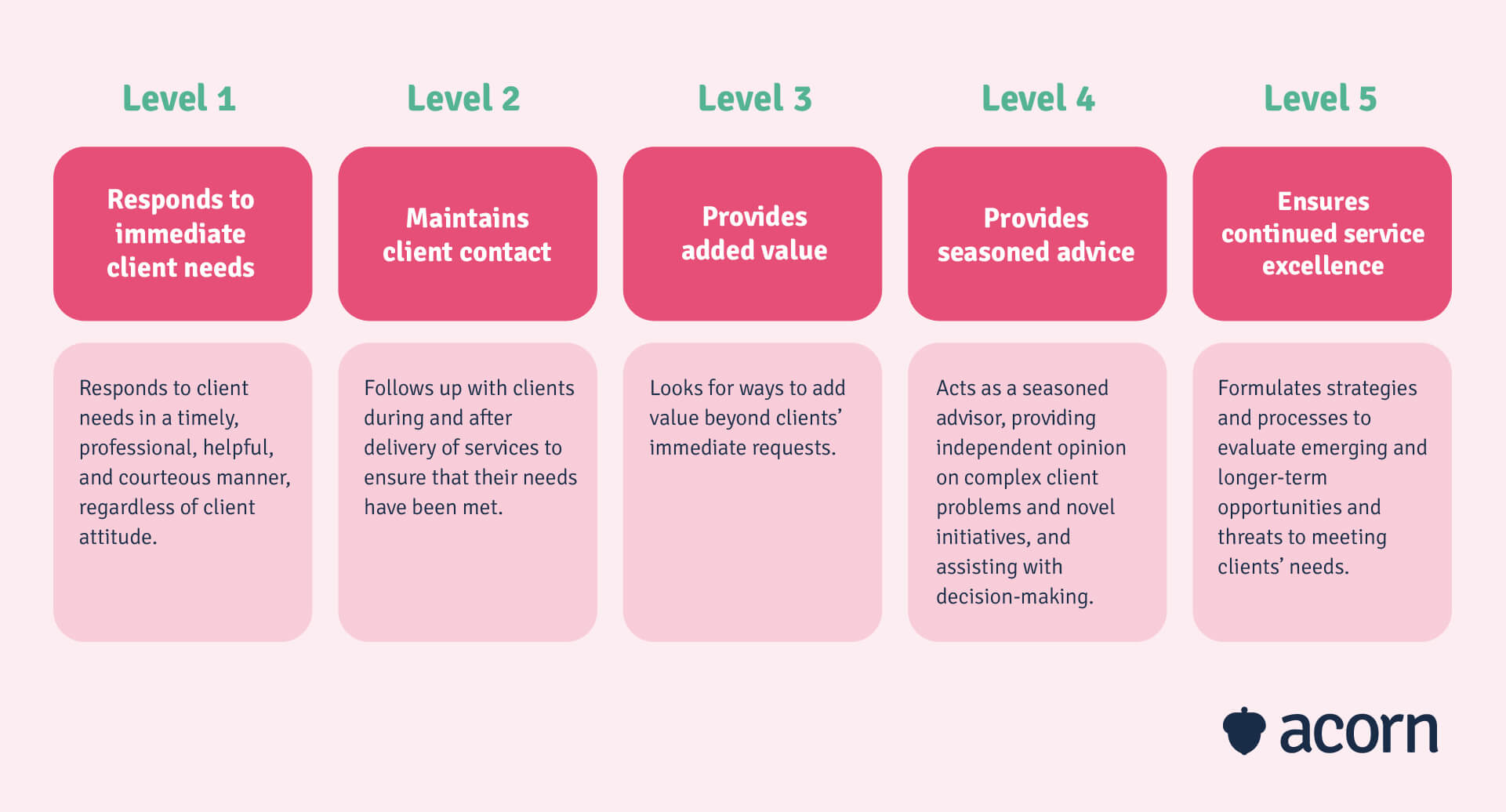Why You Need a Competency Model for Organisational Development
Reading Time:

Lead the pack with the latest in strategic L&D every month— straight to your inbox.
SubscribeCompetency models are the mortar to the capability bricks of your business.
They define the ideal performance of organisational capabilities, making them the halfway point between business strategy and employee performance.
They’re detailed in nature but not complicated to create, making them a worthwhile investment. We break down the core components of competency models (including a few examples for benchmarking) in this article.
What is a competency model?
A competency model defines a standardised and systematic way of measuring the performance needs of a job role or capability.
It also provides a framework for what performance should look like based on an increasingly complex scale of behaviours, skills, and characteristics.
The competency vs capability debate
These two words are the source of much confusion in business and HR jargon. Ultimately, they are different but complementary things.
- A capability is a combination of knowledge, skills, behaviours and processes, usually one of many that make up an organisation’s unique differentiator.
- A competency is a measure of how a capability is performed. That’s generally evidenced through behaviours and evaluated against a sliding scale of criteria, such as from foundational to advanced. You may see them referred to as key indicators or performance indicators in many US or European models.
Why use a competency model?
Truly strategic L&D is the aim for most L&D, HR and organisational development professionals, but the practicality of implementation is harder than you may think. Business leaders (aka those with power over the coin purse) want to see tangible improvements to individual performance, team effectiveness and, in turn, broader metrics like retention and revenue growth.
That comes back to the performance management practices you have in place, which means you need to ensure that you have an effective and consistent way to benchmark job roles, performance, evaluations and professional development.
Which brings us to competency models. Competencies add an exhaustive dynamism to capabilities, in that they provide a clear sense of how to perform them and guardrails of how performance can progress.
That offers:
- Benchmarks for performance evaluation across functions and localised departments
- Consistent realisation of organisational capabilities by employees
- Insight for employee self-assessments and greater self-awareness and alignment with organisation
- Accurate data for timely learning interventions
- Standards for objective recruitment and retention.
Ultimately, it means you’re accurately translating high-level business needs into employee performance indicators through strategic metrics. Which in turn means that you have verifiable data to justify L&D costs and talent management decisions to C-Suite. (A little work in the short-term for a lot of long-term gain, wouldn’t you say?)
This is the foundation on which we built the performance learning management system (PLMS). It’s the only solution designed to guide learners to master the specific capabilities of their roles, so you can prove behavioural change and the impact of individual learning experiences on performance. Using both your capability framework and competency model within Acorn PLMS, you can create truly contextual learning opportunities aligned with business strategy.
Key elements of a competency model
Keep in mind that while you can use a competency model on its own, you’ll experience the highest performance if it’s used as a supporting tool for a capability framework or capability map. A competency model does not stand alone; you’ll already have the basis of knowledge, skills and abilities expected in employees.
When developing competency models, it’s best to go as personal as possible. That means:
- Detailed definitions of behavioural or performance indicators
- An exhaustive scale of said behavioural indicators
- Supporting resources, such as guides for competency assessments.
- A visual representation of the model, even if that is simply a PDF.
Types of competency models
The thing about competencies is that they are somewhat subjective, given the measurement of behaviour and varying complexity of responsibilities. You may also have different streams of capabilities, warranting the need for different competency models.
Between job-specific, core and leadership competencies, there are a few ways you can shape your model. The world is your oyster here.
Core competency model
This model includes a more high level view of competencies, but don’t mistake that for generic. These competencies (and their corresponding capabilities) are like a baseline of successful performance across your workforce.
Consider them like core values—opposing mindsets or ways of work won’t make for good culture fit or good team dynamics, and that doesn’t bode well for productivity or retention.
The American Job Center aims their competency models at job seekers with decompositions of transferable skills and behaviours needed in the workforce.
To borrow from their Building Blocks Model, broader displays of competency that may touch your entire workforce include:
- Digital literacy. Think Understands and complies with the organisation’s privacy policy and information security guidelines.
- Health and safety, e.g. Takes actions to ensure the safety of self and others, in accordance with established personal and workplace safety practices.
- Communication. Considers others’ viewpoints and alter opinion when it is appropriate to do so.
- Problem solving. Decisively chooses the best solution after evaluating the relative merits of each possible option.
Job specific model
Just as capabilities can be mapped to job roles, job-specific or functional competencies may be required.
Job-specific competency models usually include specific references to previous training or industry standards. Take the NSW Public Sector’s Human Resource Management capability framework. One capability is Workforce strategy, where an advanced measure of competency is Contribute expert knowledge of service delivery models and labour market trends to leadership discussions on workforce strategies.
This is highly specific to the function, and therefore can only be used to assess competencies of HR professionals. The added benefit of such a niche competency model is that you can afford to be in the weeds rather than use broad competencies, making for better performance evaluations of a key business function.
Leadership competency model
Just as leadership skills and knowledge are more complex than those for individual contributors, the behaviours required of leaders are also more nuanced. They also have the added pressure of developing talent, i.e. the capability and competency levels of others.
The case for a specific leadership competency model is only made stronger if you employ a leadership capability framework separate to your core capabilities.
While UNESCO‘s competency framework swaps the capability/competency language around, their managerial competencies offer a good example of benchmarking leadership. The organisation defines six domains (translation: core leadership capabilities) each with several performance indicators (aka competency).

At this strategic level of organisational capability, it’s common to see one level of competency with several performance indicators rather than a detailed scale. The capability framework this supports is also likely to be more focused in its number of core and sub-capabilities.
Remember, we’re talking about the behaviours that need to be exhibited in order to perform successfully in a leadership role—and these are going to build on core performance indicators, too.
What are the components of competency?
Like we said, competency is highly subjective to your organisation. But a draft competency model cannot begin without understanding the common components of competency itself.
The key is not to overcomplicate things. You can have many performance indicators, but you’ll only have a few core competencies and descriptors.
Ascending levels
Performance does not exist in a vacuum, but it does exist on a sliding scale. We emphasise the sliding element of this scale, because you can’t properly assess employees if you assume that performance will only ever move in an upwards trajectory.
The grading schema could look like:
- Foundational
- Intermediate
- Advanced
- Strategic.
Or you could take a job role-based approach.
- Team member
- Team leader
- Specialist
- Executive.
In either case, you’re creating performance milestones that give tangible markers for improvement, both for employees and those assessing them. (Again, that common language.) It also shows achievable steps for progressing in competency, rather than unexplained jumps between capability levels.
We recommend sticking to four or five levels of competency most, since most of the detail is the descriptors of those levels.
Performance expectations
These are generally known as performance indicators or behavioural indicators.
The number of performance descriptors you include under each competency level is really up to you, though each descriptor will only be a one sentence statement that describes ideal display of a competency level in terms of skill, knowledge, process or behaviour.

There are a few guiding principles here.
- Use universal terms and language in order to inspire shared mental models across performance and development.
- Indicators should be measurable through an objective, much like capabilities. If in doubt: Capabilities are the what and competencies are the how. If in double doubt: Think SMART (specific, measurable, achievable, relevant and timely) goals.
- Link back to and break down on-the-job tasks. Under a foundational competency level of the capability Influence and motivate, an indicator could simply be Use facts to support claims.
How to use a competency models in organisational development
We’ve established a competency model is the blueprint for performance. That brings us to how to use them, namely in performance assessments.
If you’re working from a capability-led strategy, then it only stands that you need an equally strategic way to measure how capabilities are realised through your workforce. That means that the focus of a competency model is to develop the behavioural change necessary for capabilities to be performed successfully.
While competency models provide a fairly clear framework to begin with, there are other ways to adapt them into your performance and talent management processes.
- Creating behavioural interview questions for job interviews or scorecards. To borrow from UNESCO’s model: Provide an example of a time you inspired and motivated others to follow their ideas and vision.
- Creating behavioural statements for capability self-assessments. E.g. Reflect on feedback from coworkers and stakeholders.
- Building new job roles. Alongside their respective capabilities, competency levels paint a clearer picture of the key skills, knowledge and behaviours needed in crucial roles.
- Mapping learning content to development plans. Specific competencies can be targeted to affect more nuanced career progression for succession planning.
Key takeaways
Talent mobility, organisational agility and business sustainability rely on a constant flow of skills, knowledge and behaviours into the right roles, at the right time. All of which requires continuous development and management of those skills, knowledge and behaviours.
The bridge between the two is generally capabilities. And if capabilities are the bricks of that bridge, then competency (and a competency model) is the mortar.
Think of a model as the way to drive strategic workforce development with:
- Clear benchmarks for performance
- Universal understanding of organisational excellence
- Unique differentiators through strategic learning
- Accurate data for talent decisions.